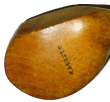
|
Registration Edit profile catalogue auction shopping cart shipping history makers search faq news links about contact |

Scottish Golf History
ClubmakersGolf balls: Spheres within Spheres(Source: © 2022, Douglas MacKenzie FSAScot) I defy anyone, even those who have no interest in golf, to spend a few hours reading about the evolution of the golf ball without finding something to pique their curiosity in amongst the bizarre materials employed, the even more bizarre applications and mis-applications of science, the wild claims and hucksterisms and the sad financial fate of many who entered this economic wild west (Alexander Graham of the Unio Golf Ball Company, Frank Johnson or Hutchison Main, for example. Each of these companies failed a few years before the start of the First World War in 1914, probably the most interesting period in terms of golf ball technology. Prior to this time it had all been pretty sensible. Featheries were ruinously expensive so gutta percha from 1848 put the game within the financial reach. The first problem to solve was gutta percha flying apart in mid flight then, realising a marked golf ball flies better than a smooth one, various covering patterns in conjunction with preventing the cover from cracking. Then it all went crazy. Make the ball fly further and roll straighter on the putting green have always been the targets but the complexities added to a little sphere are mind-boggling. First it was the core. All sorts of materials were tried and were the basis of patent infringement trials in the courts, water, compressed air, soap, gels and even, in the case of Redfern’s, liquid mercury. Punch, the satirical magazine got in on the act in 1905 describing the Explosive Golf Ball, ‘wire-wound with a core of highly compressed dynamite’, ‘No swing required. A tap will set it going’, ‘’You lay your opponent dead on the tee’. ‘You will never use any other ball’, ‘One ball will last your lifetime’. But there was, literally, plenty room to play about with at the core. ‘Spheres within spheres’ seems to have been the theme, and there must be a doctoral thesis or two in this defining the Zeitgeist which led to Niels Bohr’s atomic model. The first to set an electron spinning around a defined orbit of the nucleus was H M Singer, a gentleman from Norfolk who patented, with David Auchterlonie, (eventually patent 18,586) in 1902 a ball with a hollow interior in which a small metal, bone or other ball is free to move. An application in Singer’s name alone was filed in the United States the following year.
The diagram from the patent application by H M Singer It was claimed this would cause a ball to ‘run longer or travel farther both through the air or on the green’ though no suggestion as to why this might be the case is provided. If it increased the spin of the ball (and there is no evidence it did) then the ball would be expected to rise more rapidly but it would also descend more rapidly too. Perhaps there was a thought it would provide a gyroscopic effect with a controlled moment of inertia but, even if this were so, it would not succeed with only one ball inside in one plane. I am unclear on the Auchterlonie connection. Certainly David Auchterlonie was on the original patent application, the Auchterlonies sold these balls as the Ortogo and Singer lived part of the time in St Andrews but he was, or became, a representative of the Improved Golf Ball Company. Both it and the Auchterlonies sold this ball in models combining it with the Kingzett patent (the Ortogo-Singer and the Skor). Charles Thomas Kingzett, the chemist at the head of the firm, devised a method of alternating layers rubber and gutta which created, he claimed, a ball which would not crack. Singer’s patent allowed for the possibility of more than one ball rolling around inside the core and, as with aeroplane wings then and razor blades now, the more the merrier.
Arthur, Lord Balfour, Conservative Prime Minister between 1902 and 1905 who played golf well and did everything else badly, seems to have spread his golf mania throughout his political clique. Wilfred M Short, his private secretary, invented a putter with interchangeable faces and a golf ball with a hollow core of buffalo horn (later to become celluloid) and a spindle around which no fewer than four steels balls revolved (US Patent 737,031 granted 1903). (Indeed by the time of the US patent application the accompanying diagram showed 10 balls rolling around inside). The Gravitator Golf Ball Company was established to sell the ball of the same name.
|
site design dmc ltd | © 2000-2024 Antique Golf Clubs from Scotland

 Advertisement for W M Short’s Gravitator Ball
Advertisement for W M Short’s Gravitator Ball